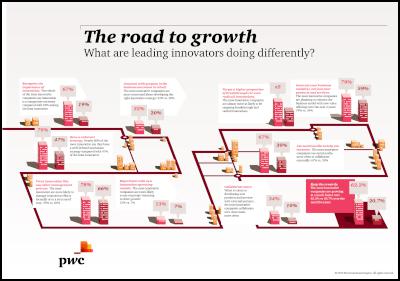Top innovators race up the growth curve
11 September 2013
News release
Top innovators race up the growth curve
PwC finds innovation is moving from the fringes into the mainstream. The world’s most innovative companies expect to grow by more than 60 percent, enjoying a NZ$318 billion revenue boost over the next five years, finds a new PwC study released at a meeting of the World Economic Forum in China today.
In the largest study of its kind, PwC asked more than 1,700 worldwide business leaders across 25 countries and 30 sectors what they see as the role for innovation in their organisations.
And the survey found there is a direct link between innovation and growth: the top 20 percent of innovators worldwide say their growth rate over the next five years will be double the global average and three times higher than the least innovative companies.
PwC New Zealand Chief Executive Officer Bruce Hassall says, “The findings are startling and clear: if you’re not innovating you’re not growing. For the first time we can now quantify and benchmark the business benefits of innovation.
“It’s exciting and confirms the findings of the recent World Economic Forum Global Competitive Index that show although we’re doing well as a good place to do business, we need to buck up our investment in innovation.
“Innovation is a competitive necessity. It should be treated like any other business process and aligned to organisational objectives to deliver serious returns. Hopefully, this is a bit of a wake-up call to New Zealanders that number eight wire thinking should have more structure around it and not left to chance,” adds Mr Hassall.
The study proves successful innovation is dependent on well-developed strategies. Nearly 80 percent of top innovators have well-defined innovation strategies, compared with less than half among the least innovative.
“Innovation is delivering transformational change. It’s for all businesses across all countries, and unlike five years ago, is overtaking globalisation as having the greater impact on growth.
“Companies are also innovating the way they innovate. It’s moved beyond products and services and the domain of tech and digital companies, it’s also relevant to the way businesses think about their business models, operating systems and customer experience,” says Mr Hassall.
The top tier of innovators identified in the study come from a diverse range of sectors from healthcare to automotive to financial services, and from India to the Netherlands and Brazil.
“Looking to China as an example of how attitudes to innovation are changing, we see its businesses are moving from a strategy of fast-follower imitation to pure innovation. China is now behind only the US in terms of its R&D spend – they’re outspending everyone else and we in New Zealand should take notice,” tells Mr Hassall.
Bucking commonly held beliefs, just one in five of the most innovative companies described their approach to innovation as ‘informal,’ compared with about one-third of the least innovative.
Yet, Mr Hassall cautions, “Innovation is not always smooth sailing, it can be disruptive or may involve a business cannibalising its own products or services for the long-term good.”
“Business leaders need to remember, there’s no single roadmap for innovation, yet by learning from others, making it a key focus and following some simple steps, they can make success more likely. Perhaps innovation is our key to jumping further ahead of Australia?” concludes Mr Hassall.
Report:
Different_Places.pdf
Infographic:

Click for big version.
ENDS


 Financial Markets Authority: FMA Seeks Clarity From High Court On Use Of Eligible Investor Certificates In Wholesale Investment Sector
Financial Markets Authority: FMA Seeks Clarity From High Court On Use Of Eligible Investor Certificates In Wholesale Investment Sector Scion: Scion’s Novel Internship Model Connects Talent With Industry
Scion: Scion’s Novel Internship Model Connects Talent With Industry Financial Markets Authority: Westpac Admits To Misleading Representations That Resulted In $6.35m In Overcharges
Financial Markets Authority: Westpac Admits To Misleading Representations That Resulted In $6.35m In Overcharges Bill Bennett: Download Weekly - Review Of 2024
Bill Bennett: Download Weekly - Review Of 2024 Bill Bennett: One NZ scores worldwide first as Starlink direct-to-mobile launches
Bill Bennett: One NZ scores worldwide first as Starlink direct-to-mobile launches Hugh Grant: How To Reduce Network Bottlenecks
Hugh Grant: How To Reduce Network Bottlenecks



